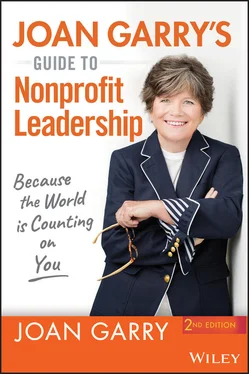Pleasers cause themselves heaps of trouble. Stretching yourself thin to make everyone happy inevitably backfires in nearly every situation — from a kindergarten class to a boardroom to a staff meeting.
The most important lesson I have learned about Elastigirl leaders is that if you can help them draw a picture of what happens as a result of pleasing, it makes them really unhappy. Elastigirls respond in the moment and do not anticipate well. It's kind of like an automatic camera — “point and shoot.” Trouble to the left? Let me fix it. Conflicting trouble to the right? I'll make you happy, too. But they can't look far enough down the road to see the implications.
Tina is an ED of a direct service organization that has a very strong client advocacy group. There had long been a push to put a member of that group on the board. Attempting to please the Client Advocacy Task Force, Tina, as ED, brought the group into a board meeting to talk about it so the group could make the pitch. Now it was time for Tina to please the board. They loved the idea. Meanwhile Ben, Director of Programs, saw the challenge a mile away. He could see that electing the chair of the task force to the board could give that task force undue power. He saw that it would be difficult for this person to be anything other than a representative of the task force rather than someone who could view the organization from 35,000 feet, as an effective board member must.
The outcome was not pleasing. The new board member came to advocate for clients. In and of itself, this was OK, but an idea he brought to the table was not in the best interest of the organization, and the board voted it down. He quit the board and undermined the credibility and reputation of Tina with anyone who would listen, including fellow board members. Tina, displeased with how she, as ED, was being treated, was recruited away. A messy leadership transition ensued (more on that in Chapter 10).
Some advice for the pleasers out there:
Tell your board chair (partner) that you have a bit of a blind spot. Gasp! Am I really suggesting that you tell your board chair that you are imperfect? Yup! You are partners, remember? Ask your board chair to help you think through the implications of decisions because you need help exercising your anticipation muscle.
Remember that a pleaser flexes too quickly and consciously slow down. The word yes can come out of your mouth so fast. Please count to 10 (or 20 or more) before saying anything. Even better, practice these words “Let me go back to my team and talk about this. They will have an important perspective on this issue.”
Keep Your Eye on the Mission at All Times. If you do, you will make better decisions and you will say “no” when you need to. You will be more effective in the long run, and that will be pleasing for everyone who cares about your mission.
Bonus: What Not to Do — Do Not Find a Bad Cop! I have seen this too many times to count. A Vice Chair who leans into the board about their fundraising commitment. A Deputy Director who institutes tough new HR policies while the ED is out of town. This is unfair to the “bad cop” and a clear sign of an ineffective leader. If you can't put on your big kid pants and make tough decisions, please reevaluate your line of work.
WHAT WAS THIS QUIZ REALLY ABOUT?
Think about what we have been talking about here. Have I mentioned anything about specific fundraising prowess, how often your board should meet, how effectively your organization measures success, or what role the audit committee should play in the development of the annual budget?
Nope. Those are skills. I wasn't talking about skills. I was talking about attributes. Because this is my pet peeve. Far too often, leaders are selected based on skills. “Well, David was the chair of the board of his alma mater — so he knows what the job is all about.” Does he? Does he have the right attributes to run a meeting and attempt to build consensus or the discipline not to roll his eyes when a fellow board member says something awfully stupid?
Attributes matter as much, if not more than skills. Attributes. Or perhaps given the roll we are on in this chapter, we should dub them superpowers .
Dear Joan,
I chair the ED search committee for our organization, and we are in the final rounds with two very different candidates. One is well known in our community and would bring gravitas to our organization. He is known to be a great fundraiser; finance and management skills are not his forte and his background in media (our sandbox) slim. The other candidate is from corporate America, basically unknown in our sector, strong in our sandbox, known for strong management and zero fundraising experience .
Oh, and did I mention that we may not hit payroll next week? And that we owe a quarter of a million dollars to vendors?
Who should we hire … Help!
Signed,
Conflicted in the Boardroom
Trust me. Any search committee could have written this.
And it's not just a board dilemma.
It's universal to anyone inside or outside of an organization considering a move into leadership. Thinking about throwing your hat in the ring for a promotion at your school — you've been a teacher but never a fundraiser? Are you the COO who feels ready for the leadership gig? Are you a current board chair with no fundraising experience? Could you be an ED that won't admit to a soul that the balance sheet is total gibberish to you?
And it's a dilemma for current leaders, working to be the nonprofit leaders their organizations deserve.
A number of years ago, a statewide human rights organization had a similar dilemma. Hire the candidate with deep roots in the issue — well known in the community, strong media skills, and a fundraising track record.
The other finalist — no chops in the sector, not a fundraiser, came from the labor movement. You know, the movement where you need to get lots of people on the same page and then fight for what you believe in? A movement in which your reps have to trust you, allow you to lead — one in which relationship building is key?
They picked the labor candidate. This candidate grabbed the reins and the organization grew in scope and impact in very short order.
How did this hire get made?
Attributes may in fact be the true superpowers of leadership.
Someone on that search committee encouraged the group to consider the “chop‐less” candidate through a different lens.
Through the lens of key leadership attributes . And in my opinion, attributes may in fact be the true superpowers of leadership. (I know it might be confusing with all these numbers floating around, four superheroes, five superpowers, but math never was my strong suit.)
And yes, I have a list.
Conviction: As each of you knows, nonprofit leadership is no walk in the park. Hey, why should it be? You are moving mountains. But without conviction in the real promise of the organization, no one will follow your lead. When I coach clients who have been leaders for a long period of time, I often ask “Are you as passionate about the mission of this organization as you were when you arrived?” When I hear a pause of any sort, we talk about it. A lot.
Authenticity: Real leadership demands it. So too does fundraising. Because it is the foundational attribute of trust.
Ever been to a fundraiser when the head of the school, or board chair is talking to you but not looking at you and not listening to you? Rather, she is, but to spot the next donor on her list — you know, the one who gives more than you do. Icky right? Because there is nothing genuine about your interaction. I'm guessing the leader didn't ask you any questions about you and how you were doing.
Читать дальше












